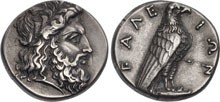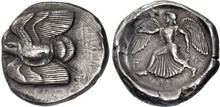NGC Ancients: The Ancient Olympic Games
Posted on 7/10/2012
Later this month, London will host the Olympics for the third time since the 1896 revival of the Games. Though the modern Olympics have become a global, multi-billion dollar event in little more than a century, the original Games were inaugurated almost three thousand years ago, in ancient Greece.
There is a general consensus that the first Olympic Games were held in 776 B.C. at Olympia, in the region of Elis in the western part of the Greek Peloponnesus. Olympia was sacred to Zeus and the first Games were held to commemorate this supreme Greek god. The Greeks held the Olympics once every four years, a period of time that came to be known as an olympiad. The only requirements for entry were that the participant be a free, Greek-speaking male (though there are accounts of women participating in the ancient Games).
Though some of the events were similar, the ancient Games did not much resemble their modern incarnation. For instance, the event was as much a religious ritual as an athletic competition. Also, rather than a rotation of different host cities, the Games were held in the same location throughout the centuries. In the ancient games there were far fewer events, and, by all accounts, the competition was more physically brutal; for example, boxing matches lasted until one participant either surrendered or died.
One characteristic that the ancient and modern Games share is the political aspect of the event. Perhaps even more so in ancient times, the Games represented a chance for political networking, the forging of alliances, and negotiation of treaties. The Olympics were a logical extension of the competition that existed at all times between the various Greek city-states. For each Games, a truce was declared between all city-states, enabling athletes from all over the Greek world to participate.
It is only natural that coinage would be struck to commemorate this important religious, political, artistic, and athletic event. One example is this rare silver stater, thought to have been struck in the later 460s B.C., thus probably for the 79th or the 80th Olympiad. It features on the obverse an eagle flying left, and on the reverse Nike running with a wreath, presumably to crown an Olympic victor.  Another rare silver stater of Olympia is thought to have been struck in 352 B.C., thus for the 107th Olympiad. It displays an artistic rendering of Zeus on the obverse, and an eagle on the reverse.
Another rare silver stater of Olympia is thought to have been struck in 352 B.C., thus for the 107th Olympiad. It displays an artistic rendering of Zeus on the obverse, and an eagle on the reverse.

Rulers, like city-states, found the Games useful for political propaganda purposes. Fifth century B.C. tetradrachms of Messana, Sicily, illustrate this point quite well. The basic design type, which served for about sixty years, shows a charioteer on the obverse and a hare on the reverse. It is thought to have been introduced by the tyrant Anaxilas in c.480 B.C. as a direct reference to his victory in the mule-cart event at the Olympic Games. This example appears to have been struck not long after this coin type was inaugurated.

For budget-conscious collectors of ancient coins, lower denomination silver issues of Olympia are an attractive option. For example, this silver hemidrachm of c.344-340 B.C., seemingly struck for the 109th or 110th Olympiad, is quite affordable by comparison with some of the earlier types. The obverse displays a portrait of the nymph Olympia, and the reverse features an eagle and a cut pomegranate. Likewise, this hemidrachm of c.276-260 B.C. (thus the 126th-130th Olympiad) is also quite affordable considering its age and importance.  As in the last case, Zeus is featured on the obverse, though this time the eagle of Zeus is replaced by his thunderbolt within a wreath.
As in the last case, Zeus is featured on the obverse, though this time the eagle of Zeus is replaced by his thunderbolt within a wreath.
The ancient Olympic games lasted, more or less without interruption, for more than a thousand years. Even as the Greeks gradually fell under Roman authority, the games continued. The emperor Nero (A.D. 54-68) shamelessly celebrated what amounted to a courtesy victory in a chariot race at the Games held during his reign. However, the growing influence of Christianity during the third and fourth centuries A.D. meant that a pagan festival such as the Olympics were in increasing danger of being suppressed. Indeed, this is exactly what happened in either A.D. 393 or 435, when Theodosius I or II (accounts differ) finally brought an end to the ancient Games.
For roughly the next fifteen hundred years, no Olympic Games were held. During the nineteenth century there was talk of a revival, and this came to fruition in 1896. Though the modern games scarcely resemble their ancient counterpart, the spirit of the ancient Greeks is preserved in the Games themselves, and in the coinage tradition that has survived the millennia to be enjoyed by collectors today.
Images courtesy of Classical Numismatic Group.
Stay Informed
Want news like this delivered to your inbox once a month? Subscribe to the free NGC eNewsletter today!
